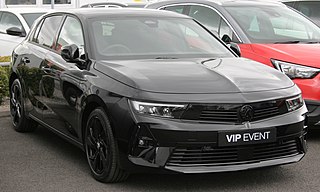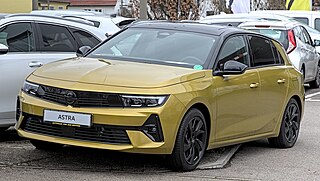
Opel Automobile GmbH, usually shortened to Opel, is a German automobile manufacturer which has been a subsidiary of Stellantis since 16 January 2021. It was owned by the American automaker General Motors from 1929 until 2017 and the PSA Group prior to its merger with Fiat Chrysler Automobiles to form Stellantis in 2021. Most of the Opel lineup is marketed under the Vauxhall brand in the United Kingdom since the 1980s. Some Opel vehicles were badge-engineered in Australia under the Holden brand until 2020, in North America and China under the Buick, Saturn, and Cadillac brands, and in South America under the Chevrolet brand.

Vauxhall Motors Limited is a British car company headquartered in Chalton, Bedfordshire, England. Vauxhall became a subsidiary of Stellantis in January 2021, having previously been owned by General Motors since 1925.

The Vauxhall Chevette is a supermini car that was manufactured by Vauxhall in the United Kingdom from 1975 to 1984. It was Vauxhall's version of the "T-Car" small-car family from Vauxhall's parent General Motors (GM), and based primarily on the Opel Kadett C. The family also included the Isuzu Gemini in Japan, the Holden Gemini in Australia, the Chevrolet Chevette in the United States, Canada, Brazil, Colombia, Ecuador and Argentina, and in the U.S. and Canada it was also rebadged as the Pontiac Acadian/Pontiac T1000.

The Vauxhall Astra is a compact car/small family car (C-segment) that has been sold by Vauxhall since 1980. Over its eight generations, it has been made at several GM/Opel/Stellantis plants around Europe - however most versions have been sourced from Vauxhall's plant at Ellesmere Port, Cheshire, England.

The Opel Astra is a compact car/small family car (C-segment) developed and produced by the German automaker Opel since 1991, currently at its sixth generation. It was first launched in September 1991 as a direct replacement to the Opel Kadett. As of 2021, the car slots between the smaller Corsa supermini and the larger Insignia large family car.

The Opel Vectra is a mid-size car that was engineered and produced by the German automaker Opel from 1988 until 2010. Available in saloon, hatchback and estate body styles, the Vectra was also sold by the Vauxhall marque in the United Kingdom as the Vauxhall Cavalier from 1988 to 1995 and then as the Vauxhall Vectra from 1995 to 2008, and it was also sold by Holden in Australia as the Holden Vectra, by Chevrolet in Latin America as the Chevrolet Vectra.

The Vauxhall Cavalier is a large family car that was sold primarily in the United Kingdom by Vauxhall from 1975 to 1995. It was based on a succession of Opel designs throughout its production life, during which it was built in three incarnations. The first generation of Cavalier, launched in 1975 and produced until 1981, was Vauxhall's version of the General Motors 'U-Car' - essentially an Opel Ascona B/ Opel Manta with a few minor visual differences.

The Opel Kadett is a small family car produced by the German automobile manufacturer Opel from 1936 until 1940 and then from 1962 until 1991, when it was succeeded by the Opel Astra.

The European Car of the Year (ECOTY) award is an international Car of the Year award established in 1964 by a collective of automobile magazines from different countries in Europe. The current organising companies of the award are Auto (Italy), Autocar, Autopista (Spain), Autovisie (Netherlands), L'Automobile Magazine (France), Stern (Germany) and Vi Bilägare (Sweden).

The Ford Orion is a small family car that was produced by Ford Europe from 1983 until 1993. A total of 3,534,239 units were sold during the car's ten-year production life.

The Opel Ascona is a large family car that was produced by the German automaker Opel from 1970 to 1988. It was produced in three separate generations, beginning with rear-wheel-drive and ending up as a front-wheel drive J-car derivative. The Ascona was developed to fill the gap in the Opel range as the Opel Rekord was gradually growing in size.

The C-segment is the 3rd category of the European segments for passenger cars and is described as "medium cars". It is equivalent to the Euro NCAP "small family car" size class, and the compact car category in the United States.
1980 in motoring deals with developments in the automotive industry that occurred in 1980, listed by country. The automotive industry designs, develops, manufactures, markets, and sells motor vehicles.
1983 in motoring deals with developments in the automotive industry throughout 1983 by various automobile manufacturers, grouped by country. The automotive industry designs, develops, manufactures, markets, and sells motor vehicles, and is one of the Earth's most important economic sectors by revenue.
1984 in motoring deals with developments in the automotive industry throughout 1984 by various automobile manufacturers, grouped by country. The automotive industry designs, develops, manufactures, markets, and sells motor vehicles, and is one of the Earth's most important economic sectors by revenue. The first practical automobile with a petrol engine was built by Karl Benz in 1885 in Mannheim, Germany.
1988 in motoring includes developments in the automotive industry throughout the year 1988 by various automobile manufacturers, grouped by country. The automotive industry designs, develops, manufactures, markets, and sells motor vehicles.
1991 in motoring includes developments in the automotive industry that occurred throughout the year 1991 by various automobile manufacturers, grouped by country. The automotive industry designs, develops, manufactures, markets, and sells motor vehicles.
1979 in motoring deals with developments in the automotive industry that occurred in 1979, listed by country. The automotive industry designs, develops, manufactures, markets, and sells motor vehicles.

The automotive industry in Germany, is one of the largest employers in the world, with a labor force of over 857,336 (2016) working in the industry.

The Opel Kadett E was introduced in August 1984 as the sixth generation of the Opel Kadett, and was voted the 1985 European Car of the Year. As with its predecessor, it was sold as the Vauxhall Astra in the United Kingdom. This model was also developed into a more conventional three-box design with a boot (trunk), badged as the Vauxhall Belmont in the United Kingdom, launched at Frankfurt Motor Show in 1985. There was a station wagon called the "Caravan", available with either three or five doors. In South Africa, the Kadett notchback was sold as the Opel Monza, along with a convertible. This replaced the Opel Ascona.

















